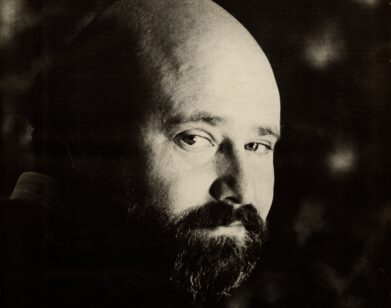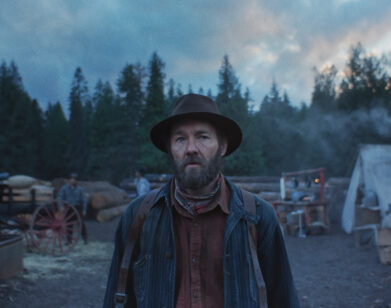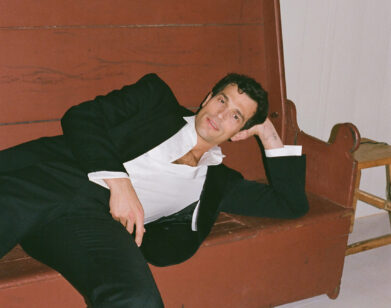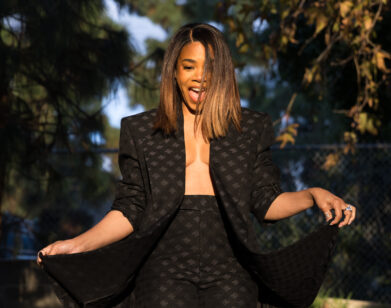Gareth Evans Returns to The Raid
It might seem odd that The Raid, a film written and directed by a Welshman named Gareth Evans, should be credited as creating an international market for Indonesian cinema. If you watch the film, however, you’ll understand. Shot in Jakarta and starring Indonesian actor Iko Uwais, The Raid is a violent, stylized, martial arts thriller about a unit of policemen whose captain has led them on a rogue mission into a Mob-infested apartment building.
Last week, The Raid 2, which made its world debut at Sundance in January, was released in New York and Los Angeles. Uwais is back as Rama, the well-intentioned, working-class policeman, and the film begins within minutes of where the first left off. This time, Rama must go undercover—first in prison and then as a gang member—to help flush out Jakarta’s corrupt government officials.
Now in his early 30s, Evans first moved to Jakarta to make a documentary, and has lived there for seven years. Though Evans has several projects he wants to pursue outside of the country, he assures us that “home will always be” in Jakarta. “I’ll always end up coming back to Jakarta because I got given my career by being here,” he continues. “I want to be able to come back and keep making movies here. If I’m lucky enough, then I get to do two out and two back in.”
EMMA BROWN: Was The Raid always meant to be the first in a series of films?
GARETH EVANS: What happened was this: the original script for The Raid 2 pre-existed The Raid 1. When I did The Raid 1, it was because I spent two years trying to get the budget for this other movie that I really wanted to make. I couldn’t find a budget, couldn’t get that up and running. I ended up side-lining that previous script and going off to work on The Raid as a backup project—as a plan B. When I was designing and developing that, I kept looking back at that old script, and that old script had nothing to do with police, nothing to do with undercover cops—it was just a normal guy, finding himself involved in the Mob. Then I starting thinking as well, “What if we made this a continuation of The Raid 1?” So The Raid 2: Berandal became this reverse engineering thing where the script for Berandal was written, and then it became retrofitted after The Raid 1 existed to make it into a sequel. Now I’ve been thinking more and more about it, and I kind of have a trilogy idea in mind, so maybe I’ll do part three as well, down the line.
BROWN: Oh, really? It’s already listed as “announced” on your IMDB page. The world has decided you’re doing it.
EVANS: Everyone keeps telling me that! I did a few interviews where I said, “Yeah, I want to do The Raid 3” and then sooner or later somebody said, “Well it’s up on IMDB” and I was like, “Oh, shit. I better start writing because I haven’t done anything on it yet—it’s all in my head.” I had no idea that IMDB could know about projects not just in development, but projects in the head of the director. So yeah, no pressure now—I have to make it now.
BROWN: Was The Raid 1 cheaper to make? Or were people just more interested in that pitch as a “first film”?
EVANS: Yeah, The Raid 1 was a lot cheaper. Just to give an example of what the situation was in terms of finance: we met a bunch of people when we were trying to get the second one made before it was a sequel, and they were all saying, “It’s too expensive, too much money, couldn’t spend that much money on an Indonesian film.” [But] I didn’t want to cut scenes out to bring down the budget on it. So in the end, I was like, “Well, I’m not going to make that film now, I’m going to make it later on when I can.” So The Raid 1 was this film where it was like, “Okay, I’ve got a sense of how much we could get through an investor” so I wrote it and designed it in a way where I could say, “This is going to cost you $1,000,000—that’s the total budget of the film, let’s make it for that much.” Then it was a lot easier to get the finance in place.
BROWN: The actor who plays Ucok, one of the main villains in the film, is fantastic. How did you discover him?
EVANS: Thank you. He’s a great actor; his name is Arifin Putra. He starred in a feature called Macabre (2009), which is an Indonesian horror film. He was one of the bad guys in that movie. I saw him in that and I always liked his performance in that film. Based off my old, previous script, he was always my first choice to play that role, so he’d been waiting for three years to play this role. He still has a copy of that old version of the script. Now, he’s managed to make that character his own and we finally got to work together on it. He’s super talented and very, very committed too. A lot of actors in Indonesia, they end up taking a lot of television work because film work isn’t really the main thing here, it’s mostly TV, and TV here kind of sucks. So I gave him an ultimatum. I said, “If you’re going to do this role, you’re not allowed to take TV work; not for two months before the shoot and not until we’re finished.” So basically I was asking him to cut out a substantial amount of his living expenses because it’s like suddenly he can’t take any of that work. He followed all of my horrible demands and gave up that period of time and devoted it entirely to this character—entirely to this project. I was blown away by him and I had the most fun working with him because he was always game to improvise a lot, so I could come up to him with last minute additional dialogue or a little scene here or there where I wanted to tweak his performance and he was always game for that kind of collaboration. We worked really closely on the character and made him this horrible Frankenstein monster of this ambitious son of a mob boss, but also mixing it with the absolute worst elements that we see in some of the rich kids in Indonesia—the spoiled rich kids who believe they’re entitled to everything, but don’t want to work for anything.
BROWN: Do you feel like you’ve met people sort of like him? Aside from the murdering people in the street part?
EVANS: [laughs] Apart from the casual approach to murder. I’ve met tons of people like that—they complain about the country; they bitch and moan about the country: “This should be better. That should be better. This needs to be fixed” or “This sucks.” They are actually in the perfect position to do something about it. They have a position of power and wealth that they could manipulate and use to be able to make things better, but they don’t. They don’t choose to do that. They just want to complain about it and leave it for somebody else to fix. I’ve met tons of people like that, so it was interesting thing for me to have this character represent that.
BROWN: What is the class system in Indonesia like compared to in the UK or the US?
EVANS: I think the class system is a little more defined here. In the UK right now, yeah, there is a class system, but the middle class, there’s a wider spread. Over here there is an emerging middle class that’s starting to become more prominent and it is changing slightly, but it still has that kind of old-fashioned class divide, which is a shame.
BROWN: Was the film inspired by research into the gangs of Indonesia, or is it complete fantasy?
EVANS: [laughs] To be honest, it’s an amalgamation of film treatment of the mafia—of gangsters and mob mentality. I didn’t want an accurate portrayal or representation of it. The film I’m making is kind of comic bookish, especially with Hammer Girl and Baseball Bat Man—they’re like comic book characters. I wasn’t striving for any kind of authenticity in terms of how the mob operates here in Indonesia. I just decided to watch a bunch of American gangster movies, Japanese gangster movies, Korean gangster movies, and try to create something that existed in my own world. The film is set in Indonesia, in Jakarta, but it’s a totally different place from what I represent in the films.
BROWN: What are some of those movies that you were watching?
EVANS: I re-watched the Takeshi Kitano films like Sonatine (1993) and Outrage (2010). And then I’d watch a lot of Takashi Miike films like Dead or Alive (1999), and lots of American gangster films: Goodfellas (1990), Casino (1995), Scarface (1983), Once Upon a Time in America (1984)—all the classic gangster films. I’d try to riff off them to see what I could pick and choose and then create my own from it.
BROWN: When The Raid came out, a lot of the reviews talked about how the film had brought back the martial arts genre. Did you feel like there was something missing in that genre of cinema when you made the film?
EVANS: Weirdly, no. When I first saw the film, for the first time after we’d finished making it all, my producer and I both had the same feeling: we knew we had something, but we didn’t know to what extent. There’s no way we could have guessed it would have gone the way it did. Our feeling was mainly that we were kind of disappointed with some of our technical imitations, so my producer and I focused way too heavily on all of the pixel details—all those little resolution issues with the camera, any sort of text situation where we thought we could have done better. We got so lost in that whole process, that what we ended up doing was blinding ourselves to the fact that what we had was something cool. When we did the screening in Toronto, it was that moment—when I heard the audience react and then they just continued to react and respond to the film and connect with it on these different levels—that I was blown away. I was completely shocked and surprised because I did not expect them to respond that way. How could I have? The film is pretty violent; the films I make are pretty extreme in places, so to have this many people respond to it, it’s been overwhelming. It’s been a huge deal for us.
BROWN: How were they responding? Was everyone gasping?
EVANS: Yeah. One of the things we do on purpose is, every fight scene we make, we have to have a punch-line element. What I mean by that is, we have the normal choreography and then we have these one or two moments, which are very big gestures—big, extreme moments. We hit you with them, but only for a split second. You get shocked by it, and then we move on. The idea is that it creates a certain amount of levity in the scene; if you can put something up there and the whole audience responds in unison—if everyone gasps at the same time—then you realize you’re in the safety of a cinema because you’re hearing everyone else make the same noise. Then suddenly, the natural instinct is to laugh because it’s the absurdity of it—the “Oh my god, how crazy was that?” moment and now we’ve shared it. It’s a communal experience where people feel free to react as big as they want, and to laugh as loud as they want, that makes it entertaining. It stops being violent on a repugnant level; it’s not repulsive. The last thing I want to do is make people feel disgusted by what they see. What I want to do is present them with something that is just so absurd that you can’t help but laugh—you can’t take it too seriously.
BROWN: What are your favorite scenes in the film? Were there any scenes that you absolutely refused to cut?
EVANS: My favorite scenes in the film are the car chase and the kitchen fight, and those scenes would never even enter my mind as being cut out, because they’re so integral to the plot, and also because they’re the big show-stopping moments. There were some things we cut along the way. It’s a weird process; every single scene, when you’re a filmmaker, you’re kind of married to. You love them and you want them to be good and be a major part of the film and be important. At the same time, there are moments where you just have to cast aside certain things and realize that they’re actually detrimental to the film—that they’re not going to push the story forward. So we did cut quite a significant amount of footage—we cut about 30 to 40 minutes of worth of deleted scenes. We cut about four or five action sequences out of the entire film. The first moment you cut it, you’re like, “Oh god, I need this. What am I doing?” But I was lucky because one of the guys from XYZ Films, Aram Tertzakian, was working alongside me with the edit. Once I thought it was a final cut, he would zip in and say, “Well, we could probably trim this down or remove this or remove that.” I’d cut it and I’d give it a day or two and then I’d watch it. If I watched it straight away, I’d notice it and feel it, but when I watched it two days later, if I didn’t miss it and if I didn’t feel like anything was gone, then it was the right thing to do. It was an important learning process.
BROWN: Were there scenes that you missed and had to reinsert?
EVANS: Absolutely. That happens every now and then. Sometimes it’s not even a scene; it might be one line of dialogue. It might just be one line of dialogue that we cut because we feel like, “It’s kind of repetition,” and then, all of a sudden, you just notice it: “That wasn’t repetition, it was reinforcement.” But that tends to be quite rare.
THE RAID 2: BERANDAL IS NOW OUT IN LOS ANGELES AND NEW YORK.







